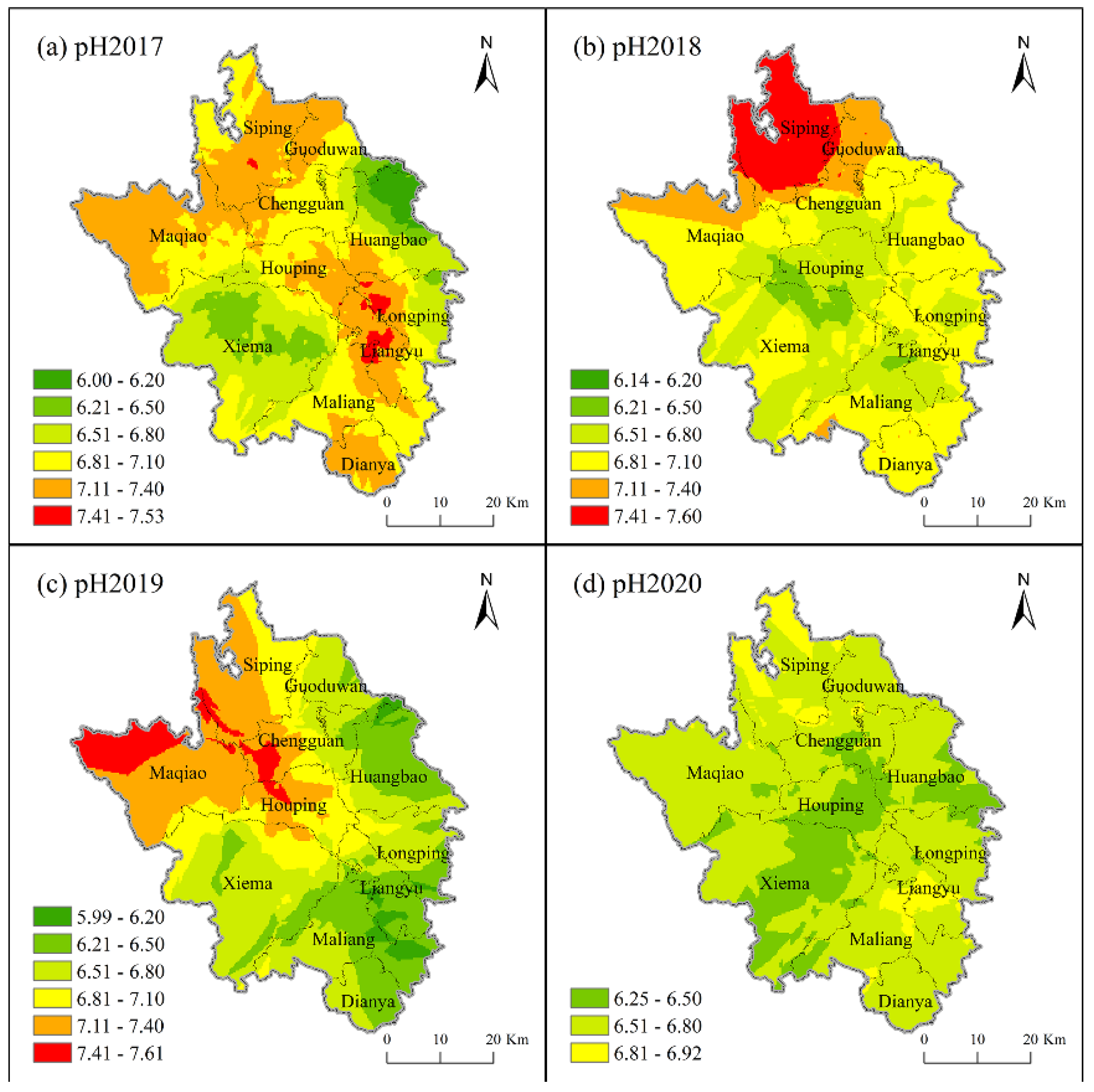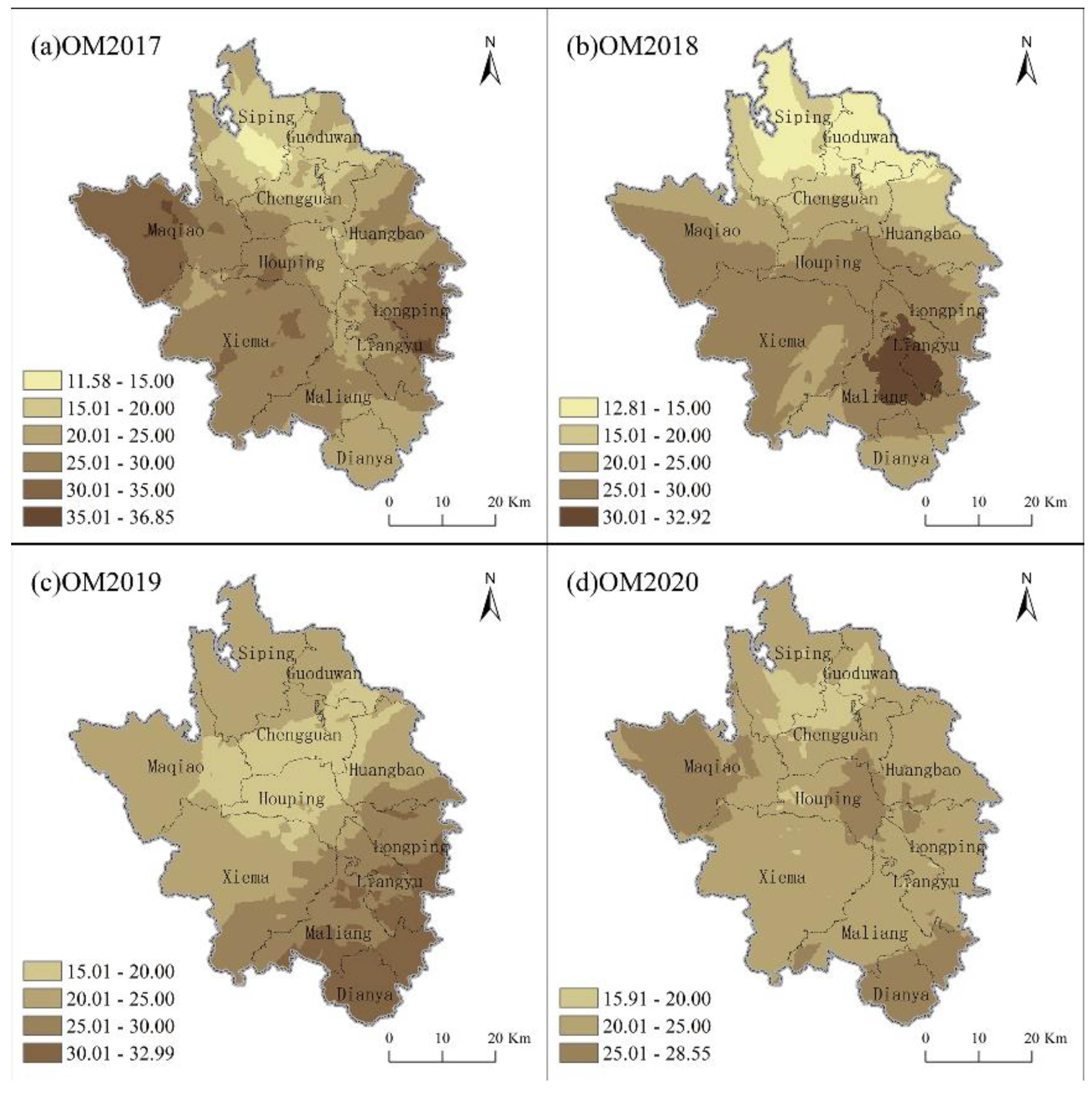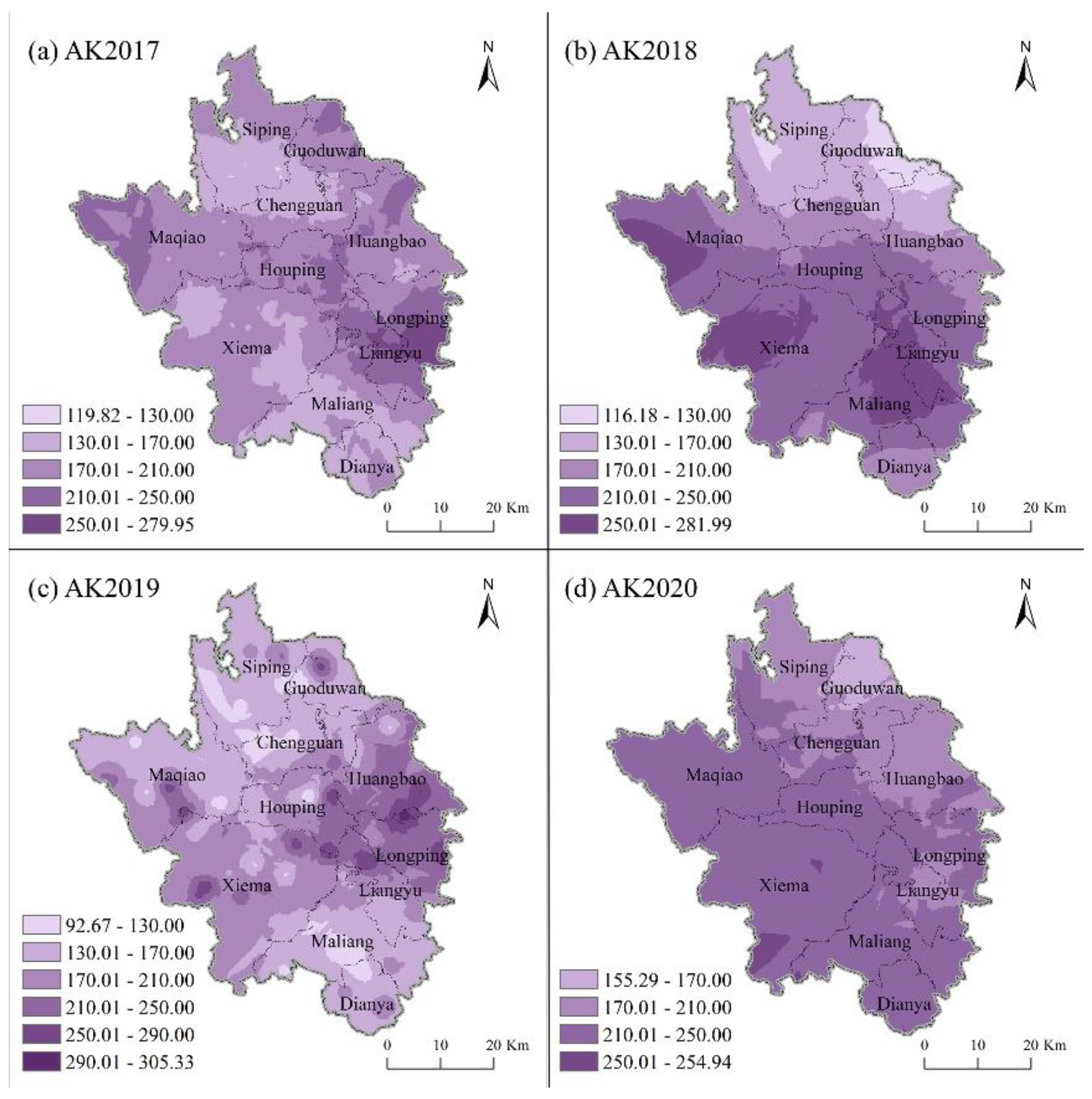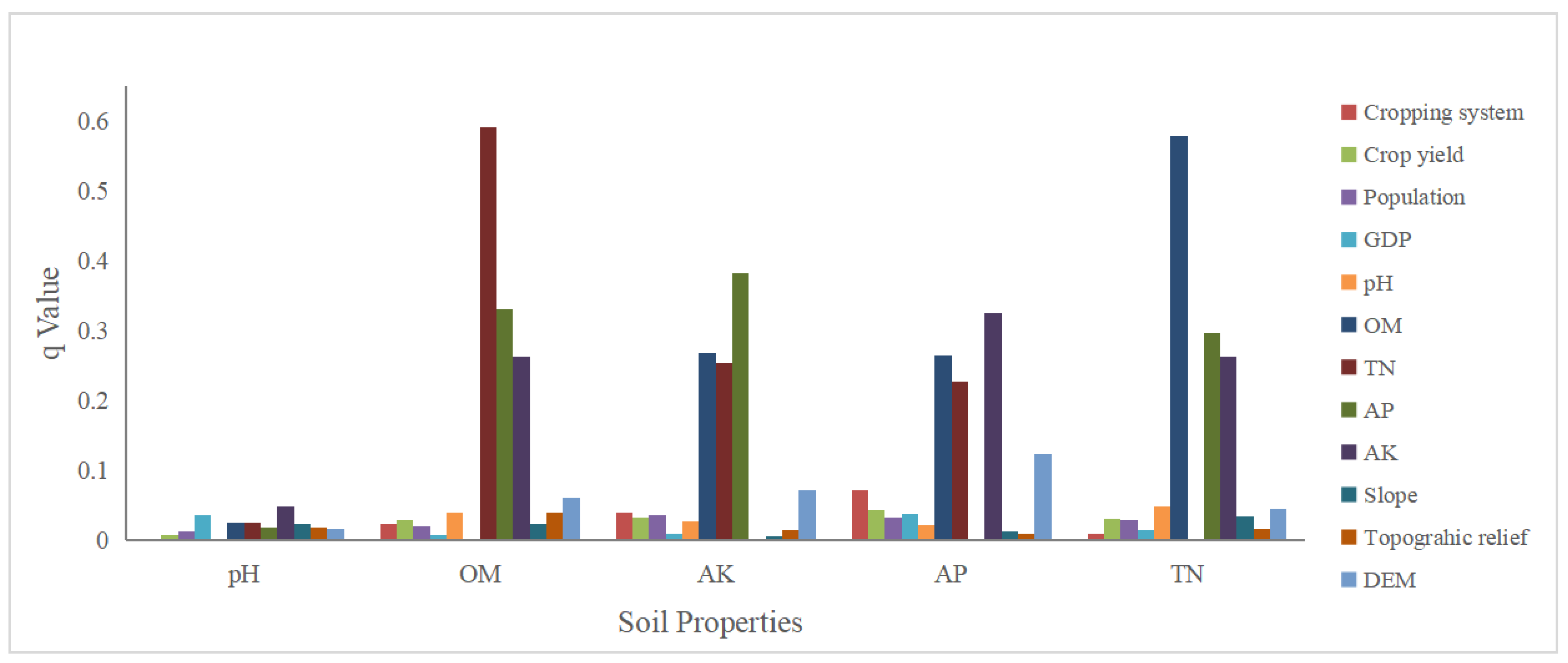Temporal and Spatial Changes and Driving Forces of Soil Properties in Subtropical Mountainous Areas from 2017 to 2020: A Case Study of Baokang County, Hubei Province, China
Abstract
:1. Introduction
2. Materials and Methods
2.1. Study Area
2.2. Sampling Design and Laboratory Analyses
2.3. Methods
2.3.1. Descriptive Statistic and Tests of Normal Distribution
2.3.2. Spatial Interpolation
2.3.3. Geographical Detector
2.4. Data Processing
3. Results
3.1. Temporal and Spatial Changes of Soil Chemical Properties in Baokang
3.1.1. Descriptive Statistic
3.1.2. Spatial Distribution of Soil Properties
3.2. Driving Forces of Soil Chemical Property Change
3.2.1. Results of Factor Detector
3.2.2. Results of Interaction Detector
4. Discussion
4.1. Possible Reasons for Soil Chemical Property Change
4.2. Suggestions for Regional Farming Practices
4.3. Strength and Weakness
5. Conclusions
Author Contributions
Funding
Data Availability Statement
Acknowledgments
Conflicts of Interest
References
- Fierer, N.; Wood, S.A.; Bueno de Mesquita, C.P. How Microbes Can, and Cannot, Be Used to Assess Soil Health. Soil Biol. Biochem. 2021, 153, 108111. [Google Scholar] [CrossRef]
- Daliakopoulos, I.N.; Tsanis, I.K.; Koutroulis, A.; Kourgialas, N.N.; Varouchakis, A.E.; Karatzas, G.P.; Ritsema, C.J. The Threat of Soil Salinity: A European Scale Review. Sci. Total Environ. 2016, 573, 727–739. [Google Scholar] [CrossRef] [PubMed]
- Lwin, C.S.; Seo, B.-H.; Kim, H.-U.; Owens, G.; Kim, K.-R. Application of Soil Amendments to Contaminated Soils for Heavy Metal Immobilization and Improved Soil Quality—A Critical Review. Soil Sci. Plant Nutr. 2018, 64, 156–167. [Google Scholar] [CrossRef]
- Song, W.; Zhang, H.; Zhao, R.; Wu, K.; Li, X.; Niu, B.; Li, J. Study on Cultivated Land Quality Evaluation from the Perspective of Farmland Ecosystems. Ecol. Indic. 2022, 139, 108959. [Google Scholar] [CrossRef]
- Nawaz, M.F.; Bourrié, G.; Trolard, F. Soil Compaction Impact and Modelling. A Review. Agron. Sustain. Dev. 2013, 33, 291–309. [Google Scholar] [CrossRef] [Green Version]
- Dai, Z.; Zhang, X.; Tang, C.; Muhammad, N.; Wu, J.; Brookes, P.C.; Xu, J. Potential Role of Biochars in Decreasing Soil Acidification—A Critical Review. Sci. Total Environ. 2017, 581–582, 601–611. [Google Scholar] [CrossRef] [PubMed]
- Palansooriya, K.N.; Ok, Y.S.; Awad, Y.M.; Lee, S.S.; Sung, J.-K.; Koutsospyros, A.; Moon, D.H. Impacts of Biochar Application on Upland Agriculture: A Review. J. Environ. Manag. 2019, 234, 52–64. [Google Scholar] [CrossRef] [PubMed]
- Luo, Y.; Teng, Y. Status of Soil Pollution Degradation and Countermeasures in China. Soils 2006, 38, 505–508. [Google Scholar]
- Zhang, S.; Zhang, X.; Huffman, T.; Liu, X.; Yang, J. Influence of Topography and Land Management on Soil Nutrients Variability in Northeast China. Nutr. Cycl. Agroecosyst. 2011, 89, 427–438. [Google Scholar] [CrossRef]
- Bogunovic, I.; Trevisani, S.; Seput, M.; Juzbasic, D.; Durdevic, B. Short-Range and Regional Spatial Variability of Soil Chemical Properties in an Agro-Ecosystem in Eastern Croatia. CATENA 2017, 154, 50–62. [Google Scholar] [CrossRef]
- Behera, S.K.; Mathur, R.K.; Shukla, A.K.; Suresh, K.; Prakash, C. Spatial Variability of Soil Properties and Delineation of Soil Management Zones of Oil Palm Plantations Grown in a Hot and Humid Tropical Region of Southern India. CATENA 2018, 165, 251–259. [Google Scholar] [CrossRef]
- Bogunovic, I.; Pereira, P.; Brevik, E.C. Spatial Distribution of Soil Chemical Properties in an Organic Farm in Croatia. Sci. Total Environ. 2017, 584–585, 535–545. [Google Scholar] [CrossRef] [PubMed] [Green Version]
- Gozukara, G.; Akça, E.; Dengiz, O.; Kapur, S.; Adak, A. Soil Particle Size Prediction Using Vis-NIR and PXRF Spectra in a Semiarid Agricultural Ecosystem in Central Anatolia of Türkiye. CATENA 2022, 217, 106514. [Google Scholar] [CrossRef]
- Ozlu, E.; Gozukara, G.; Acar, M.; Bilen, S.; Babur, E. Field-Scale Evaluation of the Soil Quality Index as Influenced by Dairy Manure and Inorganic Fertilizers. Sustainability 2022, 14, 7593. [Google Scholar] [CrossRef]
- Takoutsing, B.; Martín, J.A.R.; Weber, J.C.; Shepherd, K.; Sila, A.; Tondoh, J. Landscape Approach to Assess Key Soil Functional Properties in the Highlands of Cameroon: Repercussions of Spatial Relationships for Land Management Interventions. J. Geochem. Explor. 2017, 178, 35–44. [Google Scholar] [CrossRef]
- Guimaraes, M.F.; Fonseca, I.C.B.; Brossard, M.; Portella, C.M.R.; Brito, O.R.; Ritchie, J.C. Monitoring Changes in the Chemical Properties of an Oxisol under Long-Term No-Tillage Management in Subtropical Brazil. Soil Sci. 2008, 173, 408–416. [Google Scholar] [CrossRef] [Green Version]
- Guo, P.; Xie, Z.; Li, J.; Kang, C.; Liu, J. Relationships between Fractionations of Pb, Cd, Cu, Zn and Ni and Soil Properties in Urban Soils of Changchun, China. Chin. Geograph. Sci. 2005, 15, 179–185. [Google Scholar] [CrossRef]
- Johnson, B.G.; Verburg, P.S.J.; Arnone, J.A. Effects of Climate and Vegetation on Soil Nutrients and Chemistry in the Great Basin Studied along a Latitudinal-Elevational Climate Gradient. Plant Soil 2014, 382, 151–163. [Google Scholar] [CrossRef]
- Du, Z.; Gao, B.; Ou, C.; Du, Z.; Yang, J.; Batsaikhan, B.; Dorjgotov, B.; Yun, W.; Zhu, D. A Quantitative Analysis of Factors Influencing Organic Matter Concentration in the Topsoil of Black Soil in Northeast China Based on Spatial Heterogeneous Patterns. ISPRS Int. J. Geo-Inf. 2021, 10, 348. [Google Scholar] [CrossRef]
- Su, Y.; Li, T.; Cheng, S.; Wang, X. Spatial Distribution Exploration and Driving Factor Identification for Soil Salinisation Based on Geodetector Models in Coastal Area. Ecol. Eng. 2020, 156, 105961. [Google Scholar] [CrossRef]
- Chen, S.; Lin, B.; Li, Y.; Zhou, S. Spatial and Temporal Changes of Soil Properties and Soil Fertility Evaluation in a Large Grain-Production Area of Subtropical Plain, China. Geoderma 2020, 357, 113937. [Google Scholar] [CrossRef]
- Wu, C.; Liu, G.; Huang, C.; Liu, Q. Soil Quality Assessment in Yellow River Delta: Establishing a Minimum Data Set and Fuzzy Logic Model. Geoderma 2019, 334, 82–89. [Google Scholar] [CrossRef]
- Rosemary, F.; Vitharana, U.W.A.; Indraratne, S.P.; Weerasooriya, R.; Mishra, U. Exploring the Spatial Variability of Soil Properties in an Alfisol Soil Catena. CATENA 2017, 150, 53–61. [Google Scholar] [CrossRef]
- CMDC China Meteorological Data Service Center. Available online: http://data.cma.cn/ (accessed on 11 August 2022).
- Baokang County Archives. The Statistical Yearbook of Baokang County 2017; National Bureau of Statistics of China: Beijing, China, 2017.
- Agricultural Technology Extension Center of Baokang. The Report of Cultivated Land Survey and Evaluation in Baokang; Agricultural Technology Extension Center of Baokang: Baokang, China, 2020. [Google Scholar]
- Olsen, S.R. Estimation of Available Phosphorus in Soils by Extraction with Sodium Bicarbonate; U.S. Departement of Agriculture: Washington, DC, USA, 1954.
- Institute of Soil Sciences. Chinese Academy of Sciences (ISSCAS) Physical and Chemical Analysis Method of Soils; Shanghai Science and Technology Press: Shanghai, China, 1978; p. 283. [Google Scholar]
- Hou, L.; Liu, Z.; Zhao, J.; Ma, P.; Xu, X. Comprehensive Assessment of Fertilization, Spatial Variability of Soil Chemical Properties, and Relationships among Nutrients, Apple Yield and Orchard Age: A Case Study in Luochuan County, China. Ecol. Indic. 2021, 122, 107285. [Google Scholar] [CrossRef]
- Hodge, V.; Austin, J. A Survey of Outlier Detection Methodologies. Artif. Intell. Rev. 2004, 22, 85–126. [Google Scholar] [CrossRef] [Green Version]
- Babur, E.; Dindaroglu, T.; Danish, S.; Häggblom, M.M.; Ozlu, E.; Gozukara, G.; Uslu, O.S. Spatial Responses of Soil Carbon Stocks, Total Nitrogen, and Microbial Indices to Post-Wildfire in the Mediterranean Red Pine Forest. J. Environ. Manag. 2022, 320, 115939. [Google Scholar] [CrossRef]
- Zhu, Q.; Lin, H.S. Comparing Ordinary Kriging and Regression Kriging for Soil Properties in Contrasting Landscapes. Pedosphere 2010, 20, 594–606. [Google Scholar] [CrossRef]
- Gozukara, G.; Acar, M.; Ozlu, E.; Dengiz, O.; Hartemink, A.E.; Zhang, Y. A Soil Quality Index Using Vis-NIR and PXRF Spectra of a Soil Profile. CATENA 2022, 211, 105954. [Google Scholar] [CrossRef]
- Smirnova, E.V.; Giniyatullin, K.G.; Sahabiev, I.A.; Okunev, R.V. Comparison of Interpolated Soil Nutrients Maps Obtained with Application of Various Approaches of Ordinary Kriging. IOP Conf. Ser. Earth Environ. Sci. 2020, 548, 032027. [Google Scholar] [CrossRef]
- Wang, J.; Xu, C. Geodetector: Principle and propective. Acta Geogr. Sin. 2017, 72, 116–134. [Google Scholar]
- Qiao, P.; Yang, S.; Lei, M.; Chen, T.; Dong, N. Quantitative Analysis of the Factors Influencing Spatial Distribution of Soil Heavy Metals Based on Geographical Detector. Sci Total Environ. 2019, 664, 392–413. [Google Scholar] [CrossRef] [PubMed]
- Chen, Y.; Li, H.; Karimian, H.; Li, M.; Fan, Q.; Xu, Z. Spatio-Temporal Variation of Ozone Pollution Risk and Its Influencing Factors in China Based on Geodetector and Geospatial Models. Chemosphere 2022, 302, 134843. [Google Scholar] [CrossRef] [PubMed]
- Yuan, P.; Wang, J.; Li, C.; Xiao, Q.; Liu, Q.; Sun, Z.; Wang, J.; Cao, C. Soil Quality Indicators of Integrated Rice-Crayfish Farming in the Jianghan Plain, China Using a Minimum Data Set. Soil Tillage Res. 2020, 204, 104732. [Google Scholar] [CrossRef]
- Zhao, K.; Zhang, L.; Dong, J.; Wu, J.; Ye, Z.; Zhao, W.; Ding, L.; Fu, W. Risk Assessment, Spatial Patterns and Source Apportionment of Soil Heavy Metals in a Typical Chinese Hickory Plantation Region of Southeastern China. Geoderma 2020, 360, 114011. [Google Scholar] [CrossRef]
- West, T.O.; Post, W.M. Soil Organic Carbon Sequestration Rates by Tillage and Crop Rotation. Soil Sci. Soc. Am. J. 2002, 66, 1930–1946. [Google Scholar] [CrossRef] [Green Version]
- Li, Q.; Gu, F.; Zhou, Y.; Xu, T.; Wang, L.; Zuo, Q.; Xiao, L.; Liu, J.; Tian, Y. Changes in the Impacts of Topographic Factors, Soil Texture, and Cropping Systems on Topsoil Chemical Properties in the Mountainous Areas of the Subtropical Monsoon Region from 2007 to 2017: A Case Study in Hefeng, China. Int. J. Environ. Res. Public Health 2021, 18, 832. [Google Scholar] [CrossRef]
- Kasel, S.; Bennett, L.T.; Aponte, C.; Fedrigo, M.; Nitschke, C.R. Environmental Heterogeneity Promotes Floristic Turnover in Temperate Forests of South-Eastern Australia More than Dispersal Limitation and Disturbance. Landsc. Ecol 2017, 32, 1613–1629. [Google Scholar] [CrossRef]
- Bai, Z.; Caspari, T.; Gonzalez, M.R.; Batjes, N.H.; Mader, P.; Bunemann, E.K.; de Goede, R.; Brussaard, L.; Xu, M.; Santos Ferreira, C.S.; et al. Effects of Agricultural Management Practices on Soil Quality: A Review of Long-Term Experiments for Europe and China. Agric. Ecosyst. Environ. 2018, 265, 1–7. [Google Scholar] [CrossRef]
- Guo, Z.; Wang, J.; Chai, M.; Chen, Z.; Zhan, Z.; Zheng, W.; Wei, X. Spatiaotemporal variation of soil pH in Guangdong Province of China in past 30years. Chin. J. Appl. Ecol. 2011, 22, 425–430. [Google Scholar]
- Satiro, L.S.; Cherubin, M.R.; Lisboa, I.P.; Noia Junior, R.d.S.; Cerri, C.C.; Pellegrino Cerri, C.E. Prediction of Sugarcane Yield by Soil Attributes under Straw Removal Management. Agron. J. 2019, 111, 14–23. [Google Scholar] [CrossRef]
- Guo, X.; Li, H.; Yu, H.; Li, W.; Ye, Y.; Biswas, A. Drivers of Spatio-Temporal Changes in Paddy Soil PH in Jiangxi Province, China from 1980 to 2010. Sci. Rep. 2018, 8, 2702. [Google Scholar] [CrossRef] [PubMed] [Green Version]
- Fageria, N.K.; Baligar, V.C. Chapter 7 Ameliorating Soil Acidity of Tropical Oxisols by Liming For Sustainable Crop Production. In Advances in Agronomy; Academic Press: Cambridge, MA, USA, 2008; Volume 99, pp. 345–399. [Google Scholar]
- Jackson, R.B.; Lajtha, K.; Crow, S.E.; Hugelius, G.; Kramer, M.G.; Piñeiro, G. The Ecology of Soil Carbon: Pools, Vulnerabilities, and Biotic and Abiotic Controls. Annu. Rev. Ecol. Evol. Syst. 2017, 48, 419–445. [Google Scholar] [CrossRef] [Green Version]
- Yang, X.; Chen, X.; Yang, X. Effect of Organic Matter on Phosphorus Adsorption and Desorption in a Black Soil from Northeast China. Soil Tillage Res. 2019, 187, 85–91. [Google Scholar] [CrossRef]
- Yu, F.; Li, H. Study on Spatial Variability of Soil Organic Matter in Hubei Province based on Geostatistics and GIS. Jiangsu Agric. Sci. 2019, 47, 282–286. [Google Scholar]
- Liu, Z.; Zhou, W.; Shen, J.; He, P.; Lei, Q.; Liang, G. A Simple Assessment on Spatial Variability of Rice Yield and Selected Soil Chemical Properties of Paddy Fields in South China. Geoderma 2014, 235–236, 39–47. [Google Scholar] [CrossRef]
- Zhou, Y.; Xue, J.; Chen, S.; Zhou, Y.; Liang, Z.; Wang, N.; Shi, Z. Fine-Resolution Mapping of Soil Total Nitrogen across China Based on Weighted Model Averaging. Remote Sens. 2020, 12, 85. [Google Scholar] [CrossRef] [Green Version]
- Lu, R. Soil Analytical Methods of Agronomic Chemical; Chian Agricultural Science and Technology Press: Beijing, China, 2000. [Google Scholar]
- Yan, W.; Fan, J.; Chen, G.; Zhang, J. The spatial concentration of phosphorous mineral resources and industrial layout in Hubei province. Contrib. Geol. Miner. Resour. Res. 2015, 30, 103–110. [Google Scholar]
- Lv, Y.; Cao, J.; Wang, Z. The Formation of Environmental Pollution in Phosphate Mines and its Prevention. Conserv. Util. Miner. Resour. 2002, 6, 10–15. [Google Scholar]
- Lin, J.-S.; Shi, X.-Z.; Lu, X.-X.; Yu, D.-S.; Wang, H.-J.; Zhao, Y.-C.; Sun, W.-X. Storage and Spatial Variation of Phosphorus in Paddy Soils of China. Pedosphere 2009, 19, 790–798. [Google Scholar] [CrossRef]
- Yuan, L.; Zhang, Z.; Cao, X.; Zhu, S.; Zhang, X.; Wu, L. Responses of Rice Production, Milled Rice Quality and Soil Properties to Various Nitrogen Inputs and Rice Straw Incorporation under Continuous Plastic Film Mulching Cultivation. Field Crops Res. 2014, 155, 164–171. [Google Scholar] [CrossRef]
- Chen, Y.; Qi, Y.; Wang, Y.; Zhang, L.; Liu, J. Spatial Varibility and Factors Affecting Soil Availavle Potassium in the Central Qinling-Daba Mountain Area. Res. Environ. Sci. 2017, 30, 257–266. [Google Scholar]
- Geisseler, D.; Scow, K.M. Long-Term Effects of Mineral Fertilizers on Soil Microorganisms—A Review. Soil Biol. Biochem. 2014, 75, 54–63. [Google Scholar] [CrossRef]
- Jin, J.; Wang, L.; Müller, K.; Wu, J.; Wang, H.; Zhao, K.; Berninger, F.; Fu, W. A 10-Year Monitoring of Soil Properties Dynamics and Soil Fertility Evaluation in Chinese Hickory Plantation Regions of Southeastern China. Sci. Rep. 2021, 11, 23531. [Google Scholar] [CrossRef] [PubMed]
- Yazici, M.A.; Asif, M.; Tutus, Y.; Ortas, I.; Ozturk, L.; Lambers, H.; Cakmak, I. Reduced Root Mycorrhizal Colonization as Affected by Phosphorus Fertilization Is Responsible for High Cadmium Accumulation in Wheat. Plant Soil 2021, 468, 19–35. [Google Scholar] [CrossRef]
- Editorial Board the Statistical Yearbook of Hubei Rural 2017. The Statistical Yearbook of Hubei Rural 2017; China Statistics Press: Beijing, China, 2017. [Google Scholar]
- Du, Y.; Cui, B.; Zhang, Q.; Wang, Z.; Sun, J.; Niu, W. Effects of Manure Fertilizer on Crop Yield and Soil Properties in China: A Meta-Analysis. CATENA 2020, 193, 104617. [Google Scholar] [CrossRef]
- Qaswar, M.; Jing, H.; Ahmed, W.; Dongchu, L.; Shujun, L.; Lu, Z.; Cai, A.; Lisheng, L.; Yongmei, X.; Jusheng, G.; et al. Yield Sustainability, Soil Organic Carbon Sequestration and Nutrients Balance under Long-Term Combined Application of Manure and Inorganic Fertilizers in Acidic Paddy Soil. Soil Tillage Res. 2020, 198, 104569. [Google Scholar] [CrossRef]
- Zeng, M.; de Vries, W.; Bonten, L.T.C.; Zhu, Q.; Hao, T.; Liu, X.; Xu, M.; Shi, X.; Zhang, F.; Shen, J. Model-Based Analysis of the Long-Term Effects of Fertilization Management on Cropland Soil Acidification. Environ. Sci. Technol. 2017, 51, 3843–3851. [Google Scholar] [CrossRef]
- Liu, B.; Wu, Q.; Wang, F.; Zhang, B. Is Straw Return-to-Field Always Beneficial? Evidence from an Integrated Cost-Benefit Analysis. Energy 2019, 171, 393–402. [Google Scholar] [CrossRef]
- Nouri, A.; Lee, J.; Yin, X.; Saxton, A.M.; Tyler, D.D.; Sykes, V.R.; Arelli, P. Crop Species in No-Tillage Summer Crop Rotations Affect Soil Quality and Yield in an Alfisol. Geoderma 2019, 345, 51–62. [Google Scholar] [CrossRef]
- Descroix, L.; González Barrios, J.L.; Viramontes, D.; Poulenard, J.; Anaya, E.; Esteves, M.; Estrada, J. Gully and Sheet Erosion on Subtropical Mountain Slopes: Their Respective Roles and the Scale Effect. CATENA 2008, 72, 325–339. [Google Scholar] [CrossRef]
- Chiu, Y.-J.; Chang, K.-T.; Chen, Y.-C.; Chao, J.-H.; Lee, H.-Y. Estimation of Soil Erosion Rates in a Subtropical Mountain Watershed Using 137Cs Radionuclide. Nat. Hazards 2011, 59, 271–284. [Google Scholar] [CrossRef]
- Bünemann, E.K.; Bongiorno, G.; Bai, Z.; Creamer, R.E.; De Deyn, G.; de Goede, R.; Fleskens, L.; Geissen, V.; Kuyper, T.W.; Mäder, P.; et al. Soil Quality—A Critical Review. Soil Biol. Biochem. 2018, 120, 105–125. [Google Scholar] [CrossRef]
- Qi, Y.; Chang, Q.; Liu, M.; Liu, J.; Chen, T. County-Scale Spatial Variability of Soil Nutrient Distribution and Determination of Reasonable Sampling Density. Chin. J. Soil Sci. 2014, 45, 556–561. [Google Scholar]










| Description | Interaction Types |
|---|---|
| Weaken, nonlinear | |
| Weaken, uni- | |
| Enhance, bi- | |
| Independent | |
| Enhance, nonlinear |
| Soil Chemical Property | Year | RMSE | SEM | RMSS | MAE |
|---|---|---|---|---|---|
| pH | 2017 | 0.492 | −0.002 | 0.990 | 0.499 |
| 2018 | 0.778 | −0.029 | 0.965 | 0.811 | |
| 2019 | 1.036 | −0.002 | 0.967 | 1.067 | |
| 2020 | 0.632 | −0.009 | 1.027 | 0.617 | |
| OM | 2017 | 10.260 | −0.007 | 1.025 | 9.966 |
| 2018 | 9.956 | 0.047 | 0.971 | 10.371 | |
| 2019 | 9.708 | −0.011 | 0.977 | 9.941 | |
| 2020 | 10.768 | −0.008 | 1.067 | 10.065 | |
| AP | 2017 | 15.176 | −0.016 | 0.990 | 15.410 |
| 2018 | 10.287 | 0.047 | 1.024 | 10.302 | |
| 2019 | 9.292 | −0.015 | 0.980 | 9.482 | |
| 2020 | 9.878 | −0.020 | 0.991 | 9.981 | |
| AK | 2017 | 67.985 | −0.014 | 0.978 | 69.693 |
| 2018 | 80.058 | 0.006 | 1.026 | 78.084 | |
| 2019 | 93.506 | −0.027 | 1.003 | 93.429 | |
| 2020 | 73.640 | 0.011 | 1.045 | 70.439 | |
| TN | 2017 | 0.579 | −0.008 | 1.010 | 0.572 |
| 2018 | 0.696 | 0.004 | 1.005 | 0.693 | |
| 2019 | 0.511 | 9.456 | 1.022 | 0.499 | |
| 2020 | 0.644 | −0.003 | 1.020 | 0.632 |
| Level of pH | pH | Level of OM, AK, AP and TN | OM (g/kg) | AK (mg/kg) | AP (mg/kg) | TN (g/kg) |
|---|---|---|---|---|---|---|
| Extremely acidic | <4.5 | Very low | <6 | <30 | <3 | <0.5 |
| Very acidic | 4.5–5.0 | Low | 6–10 | 30–50 | 3–5 | 0.5–0.75 |
| Acidic | 5.0–5.5 | Lower–middle | 10–20 | 50–100 | 5–10 | 0.75–1.0 |
| Slightly acidic | 5.5–6.0 | Upper–middle | 20–30 | 100–150 | 10–20 | 1.0–1.5 |
| Neutrality | 6.0–7.5 | High | 30–40 | 150–200 | 20–40 | 1.5–2.0 |
| Alkaline | >7.5 | Very high | >40 | >200 | >40 | >2.0 |
| Types | Factors | Data Resources |
|---|---|---|
| Human activities | Cropping system | Field investigation |
| Cropping yield | Baokang County Statistics Yearbook | |
| Population | ||
| GDP | ||
| Soil factor | pH | Soil Sample data |
| OM | ||
| AK | ||
| AP | ||
| TN | ||
| Topographic factor | Slope | The Geospatial Data Cloud |
| Topographic Relief | ||
| DEM |
| Year | Mean | Max | Min | SD | CV (%) | Skewness | Kurtosis | K-sp | |
|---|---|---|---|---|---|---|---|---|---|
| pH | 2017 | 6.91 | 8.00 | 5.00 | 0.89 | 9.77 | −0.66 | 0.15 | <0.01 |
| 2018 | 6.97 | 8.00 | 5.00 | 0.79 | 9.31 | −0.16 | 0.76 | <0.01 | |
| 2019 | 6.80 | 8.00 | 5.00 | 0.77 | 9.59 | −0.61 | −0.92 | <0.01 | |
| 2020 | 6.62 | 8.00 | 5.00 | 0.56 | 8.40 | −0.11 | −0.47 | <0.01 | |
| OM | 2017 | 24.85 | 55.00 | 6.00 | 10.21 | 46.07 | 0.25 | −0.25 | <0.01 |
| 2018 | 23.63 | 47.00 | 6.00 | 9.89 | 43.39 | 0.27 | −0.87 | <0.01 | |
| 2019 | 24.59 | 49.00 | 6.00 | 10.20 | 41.57 | 0.17 | −0.55 | <0.01 | |
| 2020 | 24.46 | 41.00 | 7.00 | 10.18 | 41.07 | 0.02 | −0.37 | <0.01 | |
| AP | 2017 | 21.19 | 41.00 | 4.00 | 16.68 | 78.70 | 1.22 | 1.02 | <0.01 |
| 2018 | 21.17 | 44.00 | 2.00 | 11.24 | 55.74 | 0.27 | −0.87 | <0.01 | |
| 2019 | 20.44 | 40.00 | 5.00 | 9.69 | 43.18 | −0.44 | −0.99 | <0.01 | |
| 2020 | 20.07 | 38.00 | 4.00 | 9.24 | 44.05 | 0.04 | 0.26 | <0.01 | |
| AK | 2017 | 189.12 | 349.00 | 51.00 | 71.72 | 37.92 | 0.27 | −0.94 | <0.01 |
| 2018 | 212.20 | 342.00 | 53.00 | 87.09 | 41.04 | −0.22 | −0.27 | <0.01 | |
| 2019 | 214.73 | 348.00 | 62.00 | 92.79 | 51.34 | 0.61 | 0.29 | <0.01 | |
| 2020 | 216.22 | 335.00 | 76.00 | 71.89 | 33.25 | −0.11 | −0.04 | <0.01 | |
| TN | 2017 | 1.68 | 3.00 | 0.00 | 0.59 | 35.12 | 0.31 | 0.17 | <0.01 |
| 2018 | 1.59 | 3.00 | 1.00 | 0.77 | 39.44 | −0.25 | −0.34 | <0.01 | |
| 2019 | 1.67 | 3.00 | 0.00 | 0.54 | 30.06 | −0.35 | −0.38 | <0.01 | |
| 2020 | 1.68 | 3.00 | 1.00 | 0.62 | 36.73 | 0.03 | −0.99 | <0.01 |
Publisher’s Note: MDPI stays neutral with regard to jurisdictional claims in published maps and institutional affiliations. |
© 2022 by the authors. Licensee MDPI, Basel, Switzerland. This article is an open access article distributed under the terms and conditions of the Creative Commons Attribution (CC BY) license (https://creativecommons.org/licenses/by/4.0/).
Share and Cite
Xu, T.; Yi, S.; Zhou, Y.; Li, Q.; Liu, Y. Temporal and Spatial Changes and Driving Forces of Soil Properties in Subtropical Mountainous Areas from 2017 to 2020: A Case Study of Baokang County, Hubei Province, China. Land 2022, 11, 1735. https://doi.org/10.3390/land11101735
Xu T, Yi S, Zhou Y, Li Q, Liu Y. Temporal and Spatial Changes and Driving Forces of Soil Properties in Subtropical Mountainous Areas from 2017 to 2020: A Case Study of Baokang County, Hubei Province, China. Land. 2022; 11(10):1735. https://doi.org/10.3390/land11101735
Chicago/Turabian StyleXu, Tao, Siqi Yi, Yong Zhou, Qing Li, and Yizhu Liu. 2022. "Temporal and Spatial Changes and Driving Forces of Soil Properties in Subtropical Mountainous Areas from 2017 to 2020: A Case Study of Baokang County, Hubei Province, China" Land 11, no. 10: 1735. https://doi.org/10.3390/land11101735





